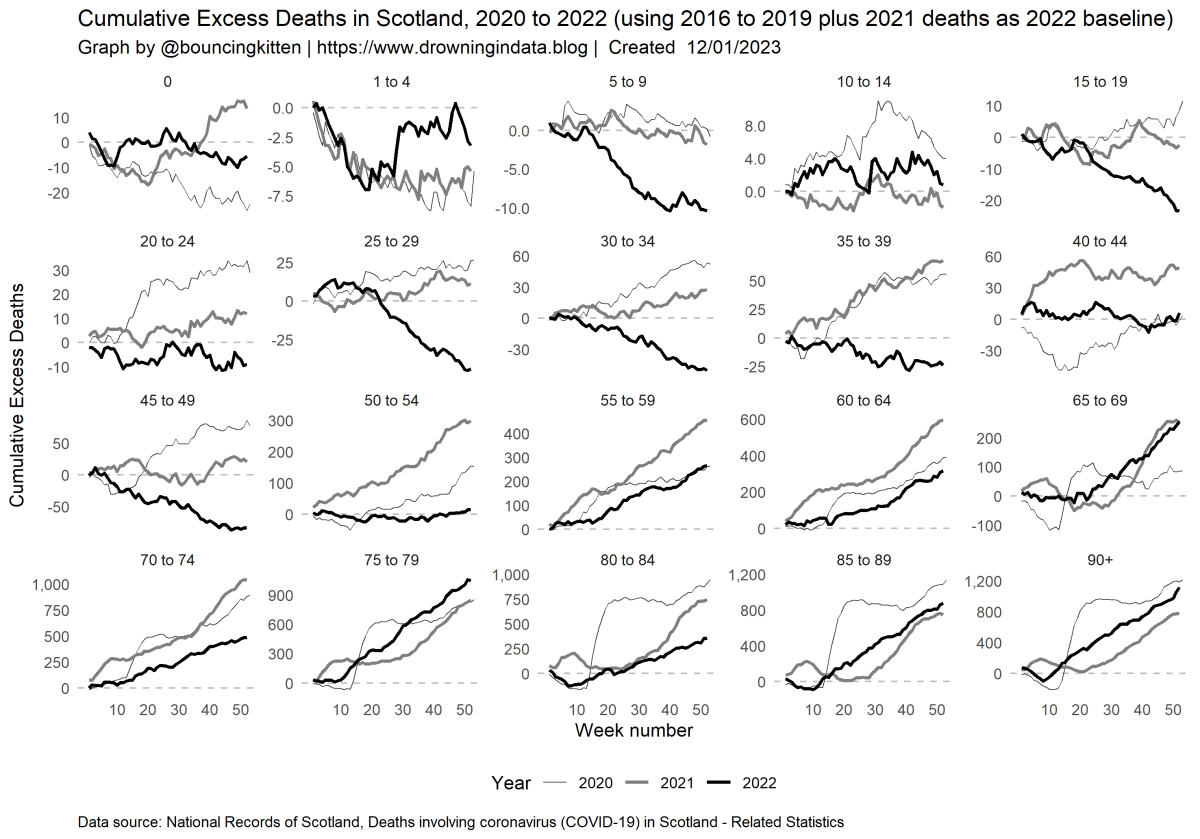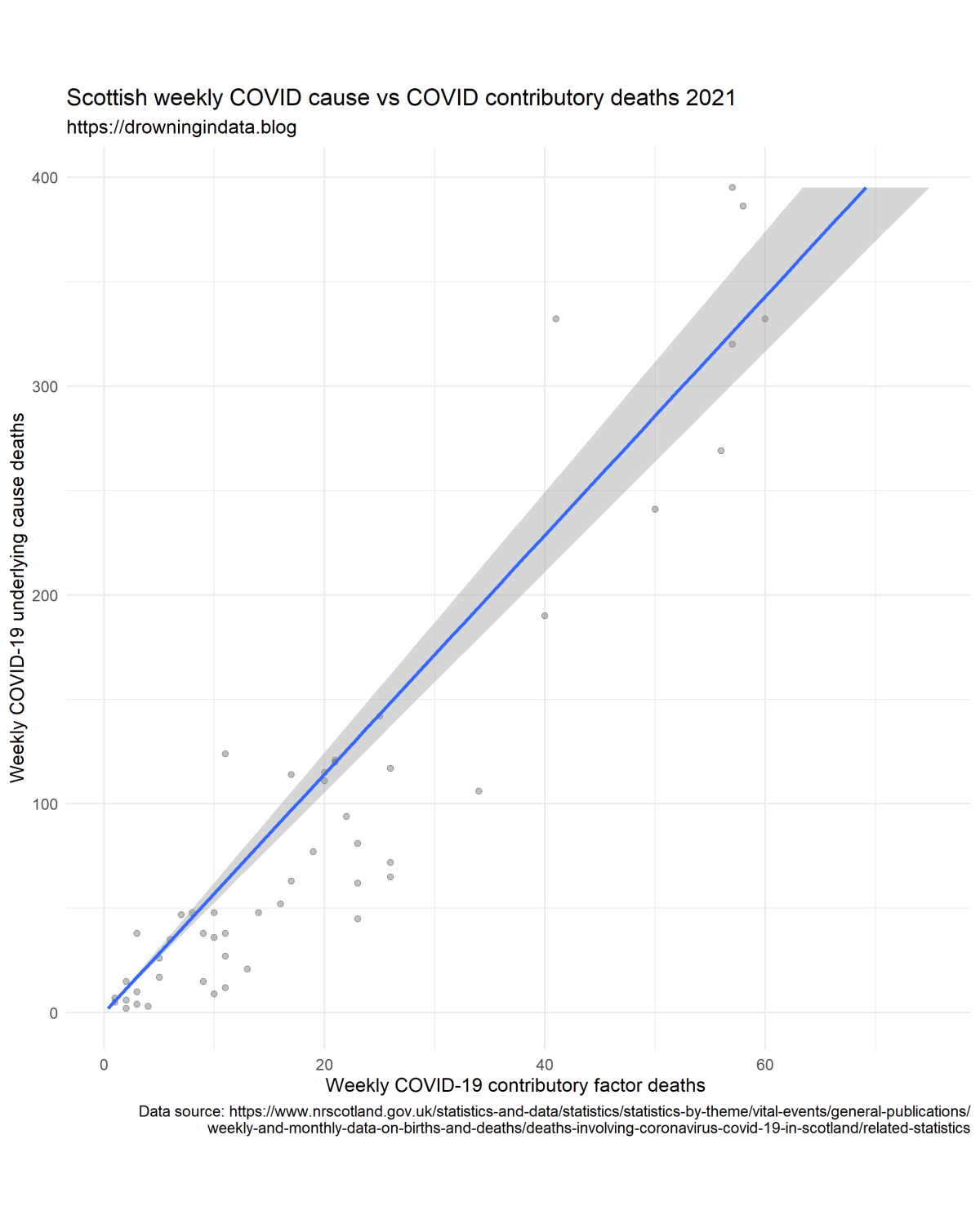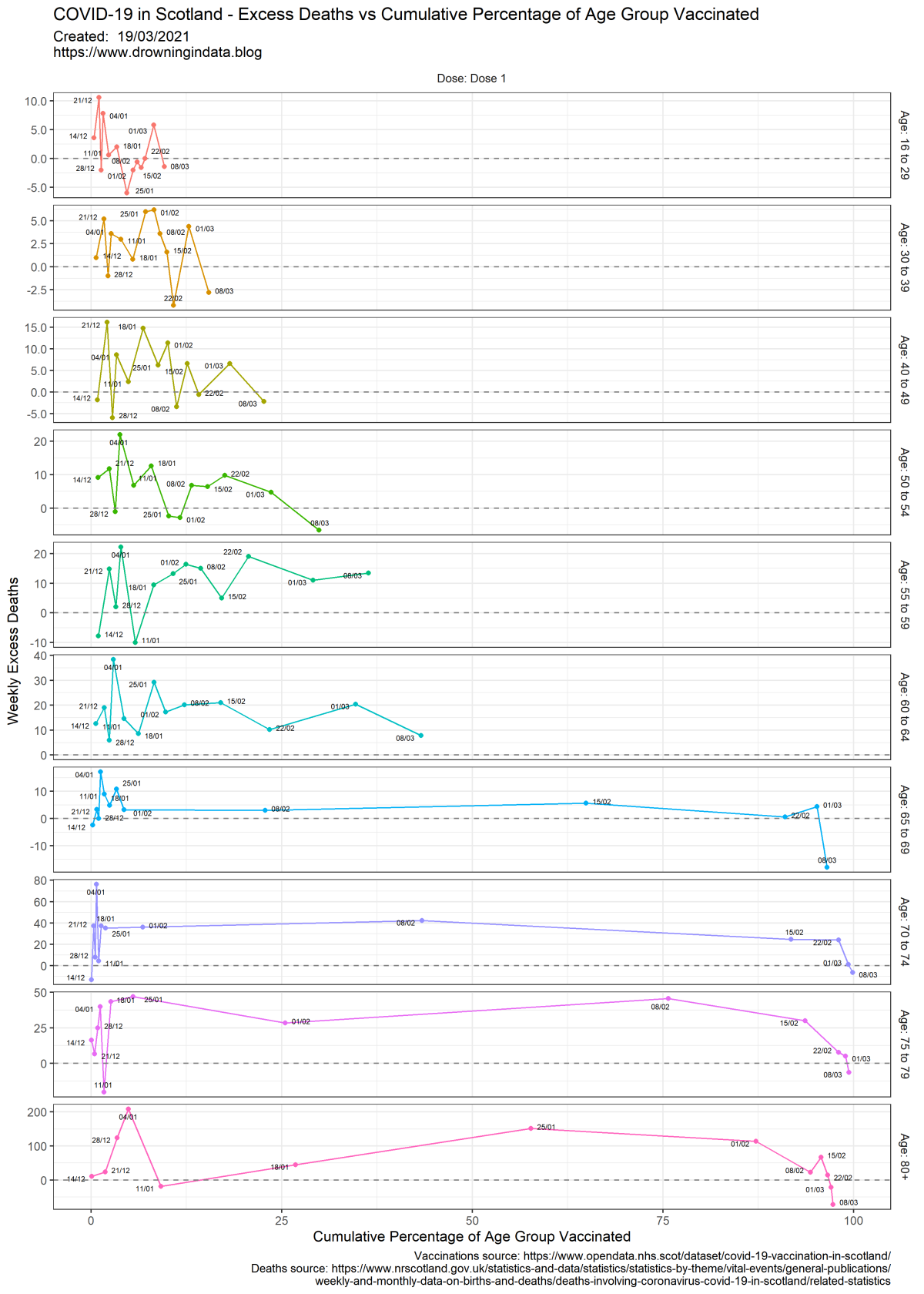Well, it’s been a wee while. I’ve had a busy year, but it looks like the various excess deaths problems I looked at a year ago haven’t gone away. Why should we bother looking at excess deaths anyway? Are these excess deaths a problem?
There’s a lot that’s been written about excess deaths and what they mean. One critical article on their use by Norman Fenton and Martin Neill states:
…one of the standard approaches for determining whether increased death counts are likely explained by COVID and/or lockdowns is to use the previous 5-year datasets of death numbers and the model ‘fitting’ approach described above…you need to be very wary if you see conclusions about the current week, month or year death numbers being ‘significantly above the 5-year average’.
https://wherearethenumbers.substack.com/p/what-can-we-learn-from-very-few-data
However, there have been various reports in the media and from the Office for National Statistics (ONS) on excess deaths and their increase over the last two years. Opinions differ about their use, but my main argument is: if the various interventions intended to prevent death from COVID-19 have been effective, shouldn’t the all cause excess deaths in 2021 and 2022 show a decrease compared to 2020? If we can see a reduction in all cause deaths in the last two years, this implies that the various COVID-19 interventions were effective and saved lives, and that the vaccination programme hasn’t caused further deaths.
Of course, it’s all a bit more complex than that due to various other economic and political factors. That aside, what do the raw data say about the excess death situation in Scotland?
First off, some background on the data. The reason I’m sharing these more detailed excess deaths data is because Public Health Scotland (PHS) on their dashboard only shares excess deaths for two age ranges: under 65 and 65 and above. This doesn’t show the full range of detail available in the deaths data, and may miss important changes in specific age groups.
I’ve published the code I used to calculate excess death and the data on my Github page.
What age categories are in the data?
I used two datasets supplied by National Records of Scotland to calculate excess deaths:
- “Weekly deaths by sex and age group, 2000 to 2019” which was used to calculate the baseline data using weekly mortality by age group from 2015 to 2019
- “Weekly deaths by sex and age group in NHS health boards, 2020 – 2022” which contains weekly deaths for 2020 to 2022 divided by cause.
The age categories are in (mostly) 5 year groups which can be seen in the weekly deaths graph for 2015-2019 shown below.
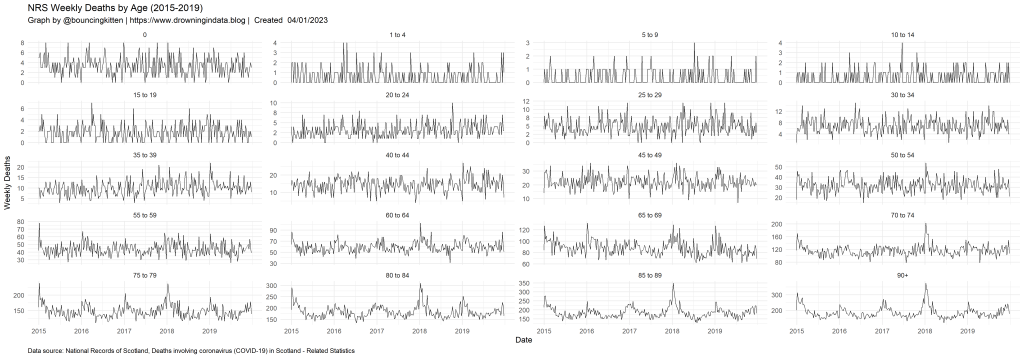
I’ve put each age group in a subplot. The range of weekly deaths is quite different for each age group – check the scales on the vertical axes before making detailed comparisons.
The 2000-2019 deaths data have different age categories to the more recent deaths data. I’ve combined the 90-94 and 95+ age ranges from the 2000-2019 deaths data into a single 90+ age range. This makes the age ranges of both datasets compatible.
Which years should be used?
The ONS changed the method used to calculate excess deaths in 2021 and 2022. Typically, deaths data from the previous five years (from 2015 to 2019) would be used to calculate a baseline for the next year. However, due to the larger number of deaths in 2020, their calculations for 2022 use deaths data from 2016 to 2019 and 2021 instead. Out of curiosity, I’ve calculated excess deaths for 2022 using both age ranges (just 2015-2019 and 2016-2019 plus 2020). Both datasets are on Github and the baseline results are shown below.
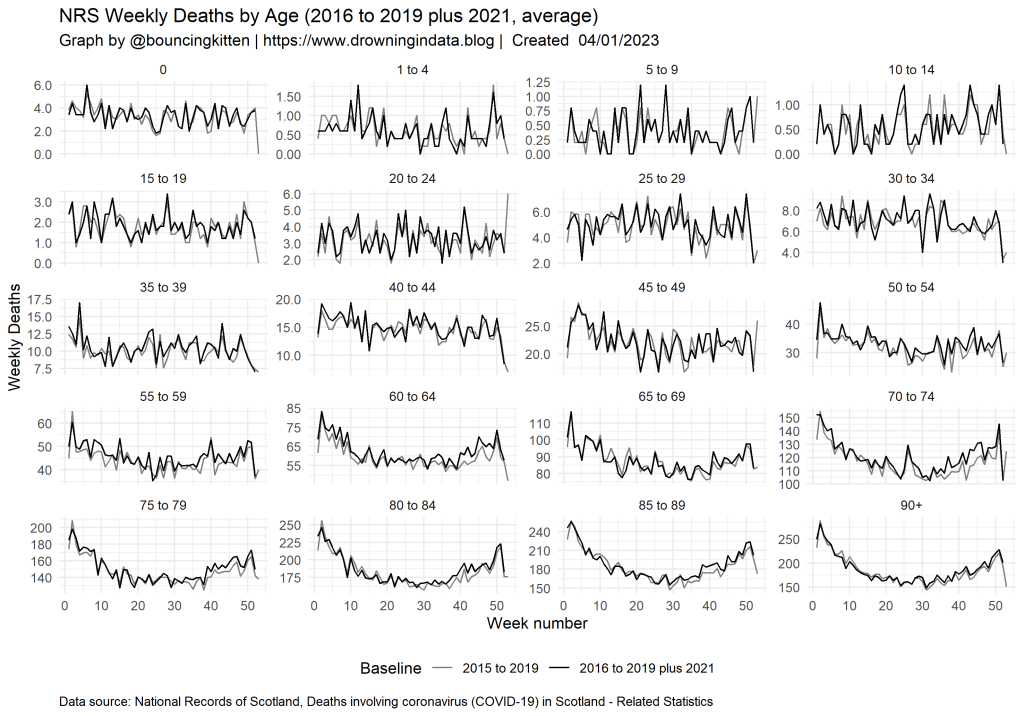
In most cases, the baseline deaths using 2015 to 2019 only are slightly lower than the baseline using 2016 to 2019 plus 2021. This slightly reduces excess deaths for 2022 based on the latter data.
Are the data complete?
John Dee’s Almanac has pointed out that deaths data for England from the ONS in 2022 aren’t yet complete. There’s a huge lack of death at the end of 2022 compared to other years. There could be several reasons for this (delays in processing data, backlogs of autopsy reports…). The Scottish data appears to be more complete, but the data should be re-checked at intervals to find updates.
Excess deaths data
Excess deaths for all the age groups in the NRS data are shown below. I’ve only shown the 2016-2019 plus 2021 excess deaths data here – the other datasets are available on Github.
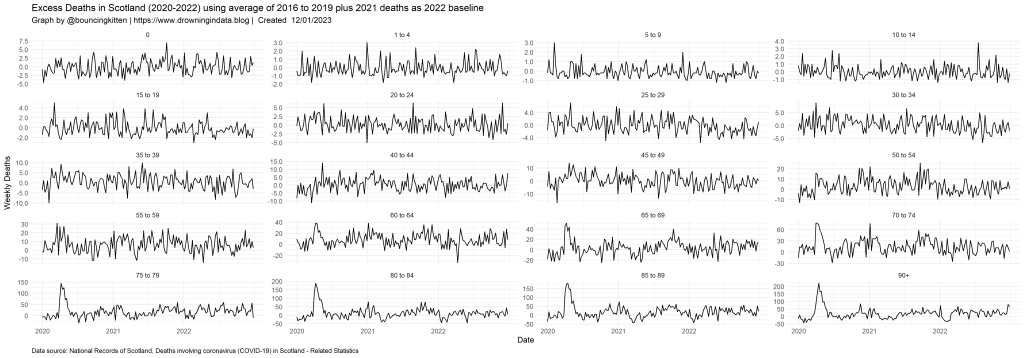
I find it hard to see what’s happening in these graphs. The high peaks in April 2020 for most age groups above 55 stick out. Apart from that, it’s hard just to glance at the graphs and see what’s going on. Calculating the cumulative excess deaths for each year can be more helpful.

The cumulative graph helps to show what’s going on more clearly. Looking through each subplot, we can see which age groups had larger excess deaths in 2022 compared to previous years.
Coming back to my original question (Have excess deaths in 2021 and 2022 decreased compared to 2020?) we can look at each graph and check where the bold black line (for 2022) and grey line (for 2021) are higher in week 52 than in 2020 (thin line).
In general, in age groups younger than 50, 2021 and 2022 showed fewer excess deaths than 2020. In some age groups (especially the youngest) there are few deaths in most years, so (for example) a 50% change in cumulative excess deaths may not be very significant.
In other age groups, three show higher excess deaths in 2022 than in 2020. These are 55 to 59, 65 to 69 and 75 to 79. Several show higher excess deaths in 2021 than in 2020. These are 50 to 54, 55 to 59, 60 to 64, 65 to 69 and 70 to 74.
Did excess deaths increase?
For the majority of the age groups who were considered the most at risk in society, excess deaths in 2021 and 2022 were generally higher than excess deaths in 2020.
Our aim in 2020 was: “Don’t kill granny”. It looks like unexpectedly high numbers of grannies died in 2021 and 2022, despite all our attempts to reduce death and infection.
